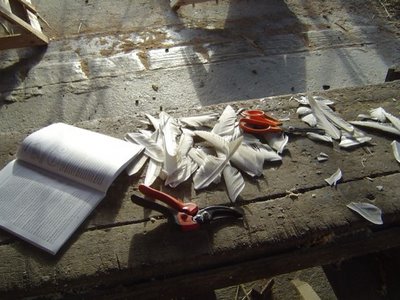
Not yet half eight and we’ve clipped the wings of five geese before breakfast! The geese spend their day eating grass, dandelions and anything else that takes their fancy within the safe confines of the electric fencing/netting. They’re getting bigger all the time and have an impressive set of wings. We’d read that domestic geese are too heavy to fly and, for our five grey Toulouse, that seems to be true. However, with a good run at it, if a strong headwind is available, they can all get airborne to some degree, the lighter white Embden being the more successful. At the end of the day, if their patch is at the top of the field, their eagerness to get back to the barn and the awaiting wheat treat means that they hare off down the field, bouncing up and down as they get airborne for a short distance: very amusing. However, yesterday evening, as we were preparing to bring them in, I glanced out to the field and something was definitely wrong. I saw nine geese inside their enclosure and one white one outside, walking up and down the fence.
It was quite blustery yesterday and so, with a favourable gust just at the right time, it must have been enough for the goose to clear the fence, however, once outside, s/he was a bit of a loss what to do. The saving grace is that the geese always want to stick together, so having flown to “freedom”, all it really wanted was to be back with the group. Having got them all safely into their house, our thoughts turned to preventing a reoccurrence and the technique of clipping their wings. We emailed our Somerset smallholding friend, Val, for advice. We also looked at a couple of websites. One helpfully warned “NEVER CLIP A WING THAT IS GROWING BLOOD FEATHERS” saying that “you will bleed the bird to death”, frustratingly with a complete lack of explanation as to what they might be and how we might recognise them: not very reassuring! Happily, another site informed us what “blood feathers” were.
Armed with a book (Starting With Geese), a pair of kitchen scissors and some secateurs, we headed for the goose house. It was impossible to separate the grey from white, so we caught them one by one, taking the grey straight out onto the field but clipping the flight feathers (on one side only) of each white bird. There was loads of noise, as you might imagine, but it all made sense once we actually had a bird in the hand, so to speak! We were apprehensive before getting started but our confidence in goose keeping has grown immensely and we felt very proud of ourselves once it was all done.
